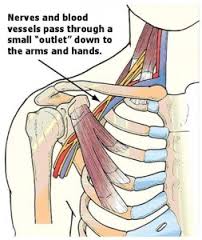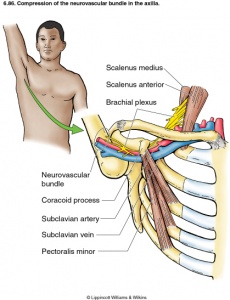Introduction
The costoclavicular passage is one of three passages that consitute the thoracic outlet; the others are the superior thoracic outlet and the costoscalene hiatus.[1] The costo-clavicular passage is formed by the clavicle antero-laterally, the first rib medially, and the scapula posteriorly.[2] The brachial nerve plexus, subclavian artery and subclavian vein run within the costoclavicular space between the first rib and the clavicle. The neurovascular bundle is vulnerable to compression in this space.[2]
Mechanism
The costoclavicular syndrome was first described in soldiers with loaded knapsacks, who developed pain, numbness, and fatigueability of the arms as they stood at attention.The mechanisms of compression involved downward movement of the clavicle against the first rib with a resultant tendency to shearing of the neurovascular bundle.[3]
This can occur in three ways:
- The clavicle depresses toward/against the first rib. This can be observed in the common postural condition of rounding and slumping shoulders. This narrows the costoclavicular passage by pushing the scapula forwards.
- A tight subclavius can also cause this to occur.[4] A similar mechanism operates in usually obese, middle aged or elderly women. Tight, narrow brassiere straps supporting heavy breasts cut into the soft tissues around the shoulders and exert direct downward pressure on the clavicles, usually around the junction of the mid and lateral thirds. A scissoring action of the clavicle against the first rib narrows the costoclavicular passage and shears the neurovascular bundle.[2]
- The first rib elevates toward/against the clavicle. This often occurs in clients who have laboured breathing. Tight anterior and middle scalenes and subclavius can also cause this to occur.[4]
- The clavicle depresses and the first rib elevates.[4]
Presenting Complaints
- Pain or ache sometimes accompanied by stiffness in the neck and shoulders, pain, paraesthesiae, and fatigueability of the upper limbs are the main presenting complaints.
- Symptoms are usually bi-lateral, though more pronounced on the dominant side.
- They are aggravated by work and exercise, particularly carrying heavy shopping bags.
- Symptoms are relieved by rest and sleep, are minimal or absent in the morning, and become pronounced as the day progresses.
- Patients occasionally complain of puffy blue hands.[2]
Examination
- The most important clues to diagnosis are the deep grooves on both shoulders where tight, narrow bra straps have cut deeply into the underlying soft tissues.
- Direct downward pressure with a forefinger in the groove reproduces symptoms.
- Invariably, there is tenderness over the acromioclavicular joint. Movements of the neck and shoulder are free. The former are painless, but shoulder movements may be slightly painful because of osteoarthritis of the acromioclavicular joint.
- There is no muscle wasting or weakness.
- Paraesthesiae when present are likely to involve the thumb and all fingers and sometimes the whole limb. They differ from the paraesthesiae of carpal tunnel compression in their distribution and timing. Phalen’s Test and Tinel’s Test are absent.
- Some patients complain of puffy blue hands. They lack the classic colour changes of Raynaud’s phenomenon and are unaffected by cold. The normal appearance of the hand in the costoclavicular syndrome helps to differentiate it from the shoulder-hand syndrome, where it is shiny, swollen, warm, and hyperaesthetic.
- Patients with this form of costoclavicular syndrome are usually younger than those with polymyalgia rheumatica, customarily a disease of the over sixties. In polymyalgia rheumatica shoulder stiffness is prominent and bilateral and may be accompanied by symptoms of systemic upset or arteritis, e.g. visual disturbances, headache, etc. Great care must be taken to exclude the other causes of neck, shoulder, and arm pain. [2]
- Costoclavicular / Military Brace / Eden’s Test is positive
Investigations
- No abnormalities are detected on routine blood tests, full blood count, erythrocyte sedimentation rate, and immunological tests for inflammatory arthritis.
- The long duration of symptoms, normal blood tests, and x rays usually showing no more than minimal degenerative change of the cervical spine and acromioclavicular joint exclude most other conditions to be considered in the differential diagnosis.
- The approximation of the clavicle to the first rib that occurs when direct downward pressure is applied on the grooves of the shoulder or on loading is difficult to demonstrate radiologically. This is due to technical difficulties in obtaining radiographs of comparable quality and of placing markers on the first rib.
- The subluxation of the acromioclavicular joint may sometimes be seen.[2]
Medical Management
- Firstly, the goal is to open the space between the clavicle and first rib.
- After placing moist heat on the region for approximately five to ten minutes, begin by working within the costoclavicular space itself. The subclavius muscle is located here and, when tight, can decrease the space by pulling the clavicle and first ribtoward each other. In addition to the subclavius, the entire costoclavicular space should be worked in case fascial adhesions are present.The tissues of the costoclavicular space should now be stretched by passively bringing the client’s arm back into extension and up into abduction. This stretch is easiest to perform with the client seated or standing. It can be done with the supine client if the client is lying at the side of the table.
- Secondly, any other muscles that can either elevate the first rib into the clavicle or depress the clavicle into the first rib should be worked. These include the scalenes, pectoralis minor and pectoralis major
- The next step is the elimination of the cause of symptoms. Patients must be advised to wear either strapless brassieres or brassieres with broad straps with a pad threaded through the strap and placed in position on the shoulders. These measures help to distribute the downward force exerted by the straps. The straps must not be too tight. Patients must avoid carrying heavy shopping bags. The use of a shopping trolley solves this problem.
- Attention to posture directed at avoiding stooping and shoulder girdle exercises helps.
- Weight reduction though seldom resulting in significant reduction in the weight of the breasts helps, if only to increase the sense of general wellbeing.
- Pain and tenderness in the acromioclavicular joint usually respond to a reduction of the distracting forces on the joint produced by the measures outlined. Some may need treatment with local ice or heat and simple analgesics.
- Occasionally an injection of corticosteroid and local anaesthetic into the acromioclavicular joint may be required. In extreme cases surgical reduction of breast size by mammo-plasty produces excellent results.[2][4]
References
- ↑ Pollak E W. Surgical anatomy of the thoracic outIet syndrome. Surg Gynaec Obstet 1980; 150: 97 – 103
- ↑ 2.02.12.22.32.42.52.6 Silva MD. The costoclavicular syndrome: a ‘new cause’. Ann Rheum Dis. 1986; 45: 916-920.
- ↑ Hughes E S R. Collective review; venous obstruction in upper extremity (Paget-Schrocttcr’s syndrome): review of 320 Cases. Surg Gvnecol Obstet 1949 ; 88 : 89-127
- ↑ 4.04.14.24.3 Falconer M, Weddel G. Costoclavicular Compression of the subclavian artery and vein. Lancet. 1943;ii: 539-44


